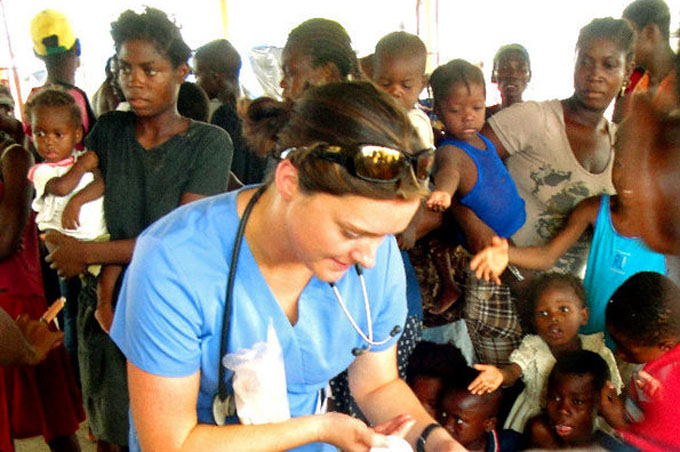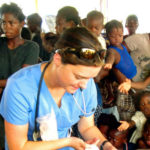RMI Instructor Kate Earle provides care to patients at a remote clinic in Haiti.With backgrounds in tactical, disaster, and emergency medicine, Remote Medical International® instructors practice what they teach. From introductory to intermediate courses, our instructors offer unrivaled training based on real-world experience. Our curriculum is a product of the emergency situations experienced by our instructors, and – as a result – our students gain exceptional insight into the quick thinking and adaptable skills necessary to excel in wilderness medicine.
Outside of the classroom, Remote Medical International’s Kate Earle has treated shark bites in the Republic of Kiribati and worked in remote Haitian clinics during the cholera epidemic. She leads Wilderness First Aid courses in Seattle, but she’s also taught the same course for a group of Mongolian nomads outside the Central Mongolian steppe. We managed to track Kate down this month in Washington DC where she is working for the Emergency Capacity Building Project. Despite her busy schedule, Kate made time to answer a few questions posed by Remote Medical International students and staff.
What’s the most interesting medical emergency you’ve ever responded to?
When I was working in post-earthquake Port-au-Prince, Haiti in a medical clinic built inside a dilapidated theme park when a middle-aged man came in with groin pain and discomfort. The patient had an inguinal hernia and a football-sized scrotum from which we could auscultate bowel sounds.
Other interesting patients in Haiti included a twenty-something year-old man who arrived at the clinic with the complaint that his mother-in-law had put a voodoo hex on him that was causing him to spend all of his money. Literally, this is how diverse emergencies can be. In general, every medical emergency in a wilderness or remote setting is “interesting†because diagnostics are limited and one is dealing with complex factors and dynamic environments.
You’ve lived and worked in all kinds of remote environments from the Indian Himalayas to the Sahara Desert. How did you use your certification (WEMT?) during these times?
I have evacuated clients on camels with severe altitude sickness in China, removed sea urchin spines from my own heel, treated a man attacked by a tiger shark in the Republic of Kiribati, and worked in Haiti post-earthquake and during the cholera epidemic. I also trained Mongolian nomads in first aid before riding a horse across the Central Mongolian steppe and assisted EMPACT Northwest in training a group of Haiti’s first EMTs. Whether using my certification and training formally or informally, it has proven to be invaluable in some of the most remote places on earth. Though these trainings have been investments in both time and sometimes money, my experiences overseas have confirmed over and over again to ask not “how can I afford this?†but rather “how can I afford not to?â€
What brought you to RMI and what courses do you teach?
I discovered RMI after living on a remote coral atoll in the Central Pacific Ocean for two years while in the Peace Corps and learning to appreciate the definition of “remote.†I started working for RMI in 2008.  Mostly, I was drawn to the work because of the exceptional group of instructors and medics at Remote Medical.  I teach WFAs, WFRs, WEMTs, and RMURs. Teaching is one of my passions.
What’s the most bizarre question a student has ever asked you?
“If I come upon an unconscious diabetic patient in the wilderness, could I chew up a Snickers bar and spit it into his or her mouth…would that work?â€
And your response?
I remember being shocked that someone could think regurgitating a Snickers into anyone’s mouth was okay. I think I said, “Stick to insta-glucose or cake frosting.* As a general rule, if you are spitting something into someone’s mouth, consider it out of your scope of practice.”
What advice would you give to a student preparing to take a WFA, WFR, or WEMT?
Come with an open mind and the expectation that you will experience moments of information overload. Understanding the pathophysiology of illnesses and injuries is far less important than developing the capacity to remain calm, think, adapt, communicate, and maintain a productive and consistent positive attitude in an emergency or rescue situation. Successful management of a critically ill or injured person, or the management of a mass-casualty incident, will depend more on your ability to maintain calm than any other medical skill or intervention. This ability will be cultivated throughout the course during training simulations. Also, wear clothes you don’t mind getting ruined.  We aim for realism and you probably don’t want fake blood and mud on your favorite things (or maybe you do), but consider yourself warned.
What part of the course do students tend to find most challenging?
The sheer amount of information. Wilderness medicine is taught through repetition because merely grasping the information in a book or manual is often worthless in an adrenaline-charged emergency. These courses also teach students to be comfortable with the gray. If you are not comfortable with the gray and with the answer “it depends,†it can be initially challenging. However, that is where the growth occurs.
Based on your experience, where do RMI students end up and how do they use their certifications?
My past students have used their certifications as: mountain guides, ski patrollers, aid workers, experiential education tour leaders, soldiers, Peace Corps volunteers, kayak and rafting guides, police officers, teachers, nannies, sailors, security officers, parents, hikers, biologists, researchers, climbers, world travelers, competitive endurance riders, and, yes, I even had a trapeze artist in one of my classes (though I hope this person never used her certification during this particular activity).
If you were stuck on a deserted island with one piece of wilderness medicine equipment, what would it be and why?
A SWAT Tourniquet. This would be good for the inevitable shark attack, and I could make a slingshot out of it in order to shoot rocks at coconuts and cause them to fall from the tree. Coconuts provide nutrient-rich food and are a naturally isotonic beverage. The husk provides fiber for rope and the shell fuel for fire. Yes, a slingshot would be good. Also, the Dental Care CRS Pack might be nice because dental issues are common on deserted islands and I wouldn’t want to re-create the Tom Hanks ice-skate scene from the movie Castaway.
If you could practice remote medicine anywhere in the world where would it be?
This one is easy: Mongolia. It is the most beautiful country on earth with a breathtaking landscape, nomadic culture, and endless sky.
*Please note: If you are reading this for medical advice, please call our office and schedule a training.




